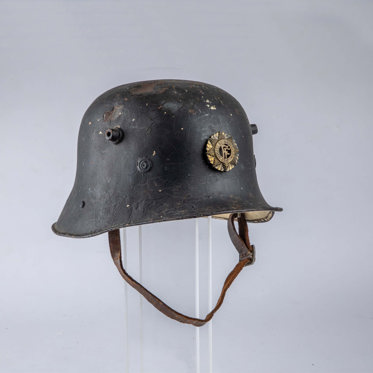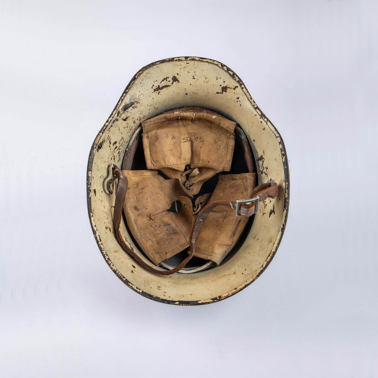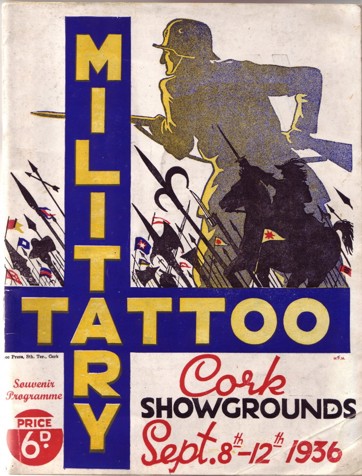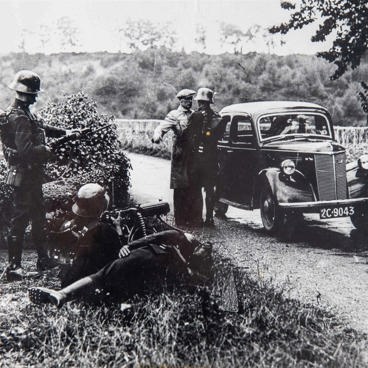The Vickers Helmet
(Above and below) Vickers helmet, DMG, Vickers M1927 helmet complete with chin strap and cap badge
Looks can be deceiving! Though this helmet has similarities with a German Army Stahlhelm used in both the Great War and World War II (or the Emergency, as it was known in Ireland), it is actually a great example of an Irish Defence Forces Vickers M1927 Helmet that saw service from the 1927 until 1940.
(Above) The Vickers helmet as seen from below
In 1927 the Stahlhelm design was adopted by the Irish army and the British company, Vickers & Co Ltd were commissioned to make 5,000 helmets. Both the German M1916 and M1918 Stahlhelms and the Vickers copy had lugs which functioned as ventilation holes but the German examples could attach a frontal armour plate to the lugs for extra protection. Unlike the Stahlhelms, Vickers helmets came with a bracket on the front to allow a cap badge to be added. Typically, Vickers helmets were painted a dark green and if they had a cap badge this was painted black. After the Vickers helmets were phased out in Ireland in 1940, many of them were repainted white and used by emergency services during the Emergency. This Vickers helmet shows evidence of being painted at least three times in its lifetime – first in dark green, then white and finally, it has been painted black. If we look inside the helmet, we can see ‘’V L’’ (denoting its manufacturer as Vickers & Co Ltd) and the serial number ‘’2685’’ can also be seen. The lining of the helmet has survived with its’ leather chin strap. The rivets holding it to the helmet are visible from the exterior. The leather workers T. Smith and Son of Dublin have their name and the year 1927 stamped into the leather. They were cast from a mild steel which meant they could dent easily (apparent on the top left of this helmet!). The helmet remained in use until it was replaced by the British Mark II Model in 1940.
(Above) Cork Military Tattoo 1936 Programme. Held in the Cork Showgrounds in 1936, the silhouette of the Vickers M1927 helmet is visible on the soldier.
(Above) Army checkpoint near Inniscara bridge c1940.
There are also two examples of the Stahlhelms in our museum collection that were donated in 1952 by General Henry Bond from Castlelyons. The Bond Family had a long history of distinguished service in the British Army. These helmets were described as souvenirs of the Great War, that one of the family had brought back from the Western Front. Interestingly, when compared side by side, the German helmets are much heavier and more robust that the Irish versions. The difference in quality is most likely an indication of the lack of adequate funds available for the government of the fledging Irish Free State to afford better equipment for their army.
Many thanks to Pascal Cullen and his family for donating this incredible piece of Irish Defence Forces history.
(Above) German troops during the Great War with M1916/M1918 helmets on their packs (Fr Scannell Collection)
Author: Eugene Kilkenny
Bibliography:
Thompson Glenn F. History Ireland, Issue 3 May/June 2009, Vol 17. Accessed at https://www.historyireland.com/artefacts-vickers-helmet/ 23-11-2023.
Forde Fiona, Irish Family Detective, Berlin or Ballincollig?, July 30, 2020. Accessed at https://www.irishfamilydetective.ie/post/berlin-or-ballincollig 23-11-2023.
Suciu Peter, Military Trader, Tommy’s ‘’Jerry Pot’’ A look at British-made German helmets, November 13, 2019. Accessed at https://www.militarytrader.com/militaria-collectibles/tommys-jerry-pot 23-11-2023.
O’Reilly Terence, An Cosantóir, ‘’Vickers Ireland’s ‘German’ Helmet’’, October 2012, pp26-27. Accessed at https://digital.jmpublishing.ie/i/84719-october-2012/25? 01-12-2023.






